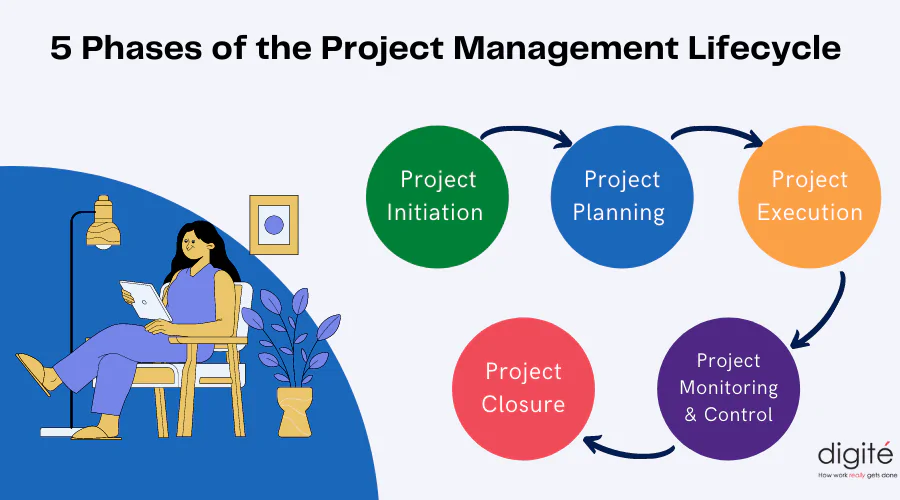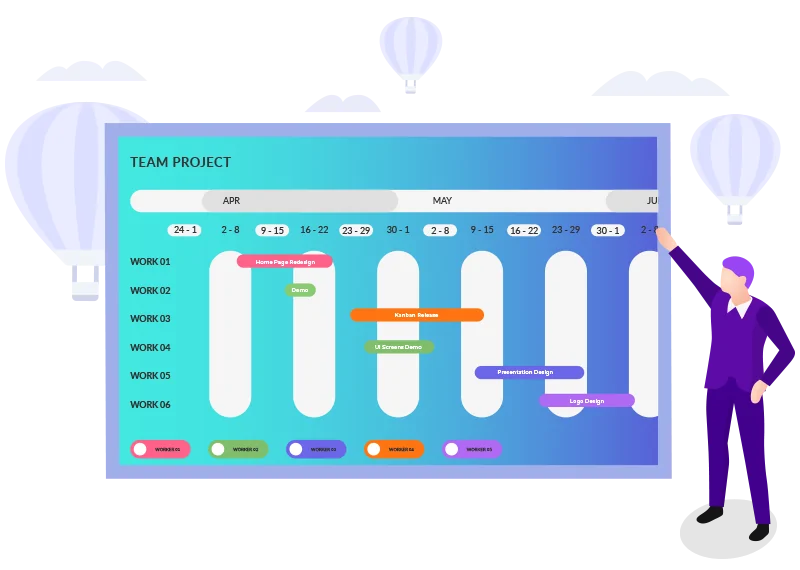What is a Project? Understanding the Fundamentals, Lifecycle, and Best Practices
- 10 mins read
-
By Bhaskar S
- Updated on June 28, 2024
Overview
A project is a temporary endeavor undertaken to create a unique product, service, or result. It’s a carefully planned and organized effort to accomplish a specific goal within defined constraints of time, budget, and resources. Unlike ongoing operations, projects have a definite beginning and end, with a clear set of objectives to be achieved.
The execution of a project requires a dedicated team, led by a project manager, who collectively possesses the necessary skills and expertise. This team is responsible for planning, executing, monitoring, and ultimately delivering the intended outcomes of the project.
Distinguishing Characteristics of Projects
While projects can vary greatly in their nature and complexity, they share certain fundamental characteristics:
1. Defined Scope and Objectives: Projects have clearly defined goals and deliverables that must be achieved within specified parameters.
2. Temporary Nature: Projects have a definite start and end date, unlike ongoing operational activities.
3. Resource Constraints: Projects operate within constraints of time, budget, and available resources.
4. Unique Outcomes: Each project is designed to produce a unique result, whether it’s a product, service, or specific outcome.
5. Cross-Functional Teams: Projects often require the collaboration of individuals from various disciplines and departments within an organization.
Project Categorization
Projects can be classified in various ways, depending on the criteria used for categorization. Here are some common ways to group projects:
By Funding Source:
☑ Internal Projects: Funded and managed within an organization.
☑ External Projects: Funded by external sources, such as clients or governmental agencies.
☑ Joint Ventures: Collaborative projects funded by multiple stakeholders.
By Industry:
☑ Construction Projects: Building infrastructure, residential, or commercial structures.
☑ Software Development Projects: Creating software applications or systems.
☑ Research and Development Projects: Developing new products, technologies, or processes.
☑ Marketing and Advertising Projects: Executing marketing campaigns or branding initiatives.
By Methodology:
☑ Waterfall Projects: Following a sequential, linear approach with distinct phases.
☑ Agile Projects: Utilizing an iterative and incremental approach with shorter development cycles.
☑ Hybrid Projects: Combining elements of both waterfall and agile methodologies.
Project Examples
To better illustrate the concept of a project, let’s explore a few examples from various domains:
☑ Construction: Building a new office complex or renovating an existing commercial space.
☑ Information Technology: Implementing a new enterprise resource planning (ERP) system or migrating data to a cloud-based platform.
☑ Product Development: Designing and launching a new consumer electronics device or a line of clothing.
☑ Event Management: Organizing a large-scale conference, trade show, or fundraising gala.
☑ Business Process Improvement: Streamlining supply chain operations or optimizing customer service processes.
Key Project Management Terminology
To effectively communicate and collaborate within project teams, it’s essential to understand some of the key terminology used in project management:
1. Project Charter: A formal document that authorizes the project, defines its objectives, and outlines the high-level requirements and constraints.
2. Work Breakdown Structure (WBS): A hierarchical decomposition of the project into manageable components, tasks, and deliverables.
3. Critical Path: The sequence of tasks that determines the shortest possible duration for completing the project, with any delay directly impacting the overall project timeline.
4. Risk Management: The systematic process of identifying, analyzing, and mitigating potential risks that could negatively impact the project’s objectives.
5. Change Control: The process of formally introducing, evaluating, and approving or rejecting changes to the project’s scope, schedule, or budget.
The Project Management Life Cycle
Most projects follow a standardized life cycle, which serves as a framework for effectively managing and controlling the project from inception to completion. The typical project management life cycle consists of the following phases:
1. Initiation: Defining the project’s objectives, scope, and obtaining the necessary approvals and resources.
2. Planning: Developing a comprehensive project plan, including schedules, budgets, resource allocation, and risk mitigation strategies.
3. Execution: Carrying out the project activities according to the plan, while monitoring progress and addressing any issues or changes.
4. Monitoring and Control: Continuously tracking and evaluating project performance, identifying deviations from the plan, and implementing corrective actions as needed.
5. Closure: Formalizing the acceptance of project deliverables, documenting lessons learned, and officially closing out the project.
Project Management Best Practices
Adhering to industry-recognized best practices can significantly increase the chances of project success. Here are some essential best practices for effective project management:
1. Stakeholder Engagement: Identifying and actively involving all relevant stakeholders throughout the project lifecycle to ensure their needs and expectations are met.
2. Clear Communication: Establishing open and consistent communication channels among project team members, stakeholders, and sponsors to facilitate collaboration and decision-making.
3. Risk Mitigation: Proactively identifying, assessing, and addressing potential risks to minimize their impact on project objectives.
4. Change Management: Implementing a structured process for evaluating, approving, and controlling changes to the project’s scope, schedule, or budget.
5. Continuous Improvement: Regularly reviewing project performance, capturing lessons learned, and incorporating improvements into future projects.
By following these best practices, project managers can navigate the complexities of project execution, ensure alignment with organizational goals, and deliver successful outcomes that meet stakeholder expectations.
Roles and Responsibilities in Project Management
Successful project execution relies on the coordination and collaboration of various roles and responsibilities within the project team. Here are some key roles and their primary responsibilities:
1. Project Sponsor: The individual or group within the organization that provides the financial resources and executive support for the project. They are ultimately accountable for the project’s success.
2. Project Manager: The leader responsible for planning, executing, monitoring, and controlling the project from start to finish. They ensure that the project objectives are met within the defined constraints of time, budget, and scope.
3. Project Team Members: The individuals with the necessary skills and expertise who perform the actual work to complete the project tasks and activities.
4. Subject Matter Experts (SMEs): Specialists or consultants who provide specific domain knowledge or technical expertise to the project team as needed.
5. Project Management Office (PMO): A centralized group or department within an organization that provides guidance, standards, and best practices for project management methodologies and processes.
Project Management Tools and Techniques
To effectively plan, execute, and control projects, project managers and teams leverage a variety of tools and techniques. Some commonly used tools and techniques include:
1 Project Management Software: Comprehensive platforms that provide features for task scheduling, resource allocation, time tracking, collaboration, and reporting.
2. Gantt Charts: Visual representations of project schedules, displaying tasks, dependencies, and timelines.
3. Critical Path Method (CPM): A technique for identifying the critical path and calculating the earliest and latest start and finish times for project activities.
4. Earned Value Management (EVM): A methodology for measuring project performance by comparing the planned value, earned value, and actual costs.
5. Risk Analysis: Techniques such as risk registers, probability-impact matrices, and risk response strategies to identify, assess, and mitigate potential risks.
6. Stakeholder Analysis: A process for identifying stakeholders, assessing their interests and influence, and developing appropriate engagement strategies.
By leveraging these tools and techniques, project managers can effectively plan, execute, and control projects, ensuring successful delivery and stakeholder satisfaction.
Organizational Project Management
As organizations increasingly rely on projects to drive innovation, growth, and strategic initiatives, effective project management has become a critical competency. Many organizations have adopted organizational project management (OPM) practices to standardize and optimize their project management processes across the enterprise.
OPM involves establishing a project management framework, including policies, methodologies, tools, and governance structures, to ensure consistent and efficient project execution. It often involves the creation of a Project Management Office (PMO) to provide centralized oversight, support, and guidance to project teams across the organization.
By implementing OPM practices, organizations can improve project success rates, enhance resource utilization, foster knowledge sharing, and better align projects with organizational strategies and objectives.
According to the Project Management Institute’s (PMI) Pulse of the Profession report, organizations that undervalue project management as a strategic competency for driving change report an average of 67% more of their projects failing outright.
Furthermore, the same report indicates that high-performing organizations successfully complete 77% of their projects, while low performers complete only 56% of theirs, highlighting the critical role of project management in organizational success.
These statistics emphasize the significant impact that well-managed projects can have on an organization’s ability to achieve its strategic objectives and drive innovation. As businesses increasingly rely on projects to navigate complex challenges and opportunities, understanding the fundamentals of project management becomes crucial for professionals across various industries.
Nimble’s intuitive project management platform streamlines the entire project lifecycle, from planning to execution and monitoring. With features like customizable workflows, real-time collaboration tools, and advanced analytics, Nimble empowers teams to manage projects more efficiently, enhance communication, and deliver successful outcomes aligned with organizational goals.
Project Portfolio Management
In many organizations, multiple projects are often running concurrently, each with their own objectives, resource requirements, and constraints. Project portfolio management (PPM) is a strategic approach to analyzing, prioritizing, and managing an organization’s portfolio of projects to ensure alignment with overall business goals and optimal resource allocation.
Key aspects of PPM include:
1. Project Selection: Evaluating and prioritizing potential projects based on factors such as strategic fit, anticipated benefits, risks, and resource requirements.
2. Resource Allocation: Allocating limited resources (human, financial, equipment) across the project portfolio to maximize value delivery and minimize conflicts or bottlenecks.
3. Portfolio Monitoring and Control: Continuously monitoring the performance of the project portfolio, making adjustments as needed, and terminating projects that are no longer aligned with organizational objectives or priorities.
4. Portfolio Optimization: Periodically reviewing and rebalancing the project portfolio to ensure it remains aligned with evolving business strategies and priorities.
Effective PPM helps organizations make informed decisions about which projects to pursue, ensuring that resources are focused on the most valuable initiatives and enabling better coordination and optimization across the project portfolio.
Project Management Certifications and Professional Development
As the demand for skilled project managers continues to grow across industries, various professional certifications and educational programs have emerged to enhance project management knowledge and competencies. Some widely recognized certifications include:
1. Project Management Professional (PMP)®: Offered by the Project Management Institute (PMI), this globally recognized certification validates an individual’s knowledge and experience in leading and directing project teams.
2. Certified Associate in Project Management (CAPM)®: Also offered by PMI, this certification is designed for entry-level project managers or those seeking to demonstrate their understanding of project management principles.
3. Certified Scrum Master (CSM): This certification, provided by Scrum Alliance, focuses on the Scrum framework and equips individuals with the knowledge and skills to effectively facilitate and lead Agile projects.
4. PRINCE2®: A widely recognized project management certification, particularly in the United Kingdom and Europe, that provides a structured methodology for managing projects.
In addition to certifications, many universities and professional organizations offer Project Management degree programs, specialized courses, and continuing education opportunities to support the ongoing professional development of project managers.
Project Management and Organizational Strategy
Effective project management is not only crucial for the successful delivery of individual projects but also plays a vital role in supporting and enabling an organization’s overall strategy and objectives. By aligning project portfolios with strategic priorities, organizations can ensure that their resources and efforts are focused on initiatives that drive value and contribute to their long-term goals.
Project management practices can also foster organizational agility, enabling organizations to respond quickly to changing market conditions, customer demands, or emerging opportunities by efficiently launching and executing new projects.
Furthermore, the principles of project management, such as risk management, stakeholder engagement, and continuous improvement, can be applied beyond individual projects to enhance organizational processes, decision-making, and overall operational efficiency.
As organizations increasingly recognize the strategic value of project management, many are investing in building robust project management capabilities, establishing project management offices (PMOs), and fostering a project-centric culture to drive innovation, growth, and competitive advantage.
Agile Project Management
While traditional project management methodologies like Waterfall follow a sequential, plan-driven approach, Agile project management takes an iterative and incremental approach. Agile methodologies, such as Scrum and Kanban, have gained widespread adoption, particularly in the software development and IT sectors, but their principles can be applied to various types of projects.
Key aspects of Agile project management include:
1. Iterative Development: Projects are broken down into small, manageable increments or sprints, with each iteration delivering a potentially shippable product increment.
2. Cross-functional Teams: Agile teams are self-organizing and cross-functional, with members possessing diverse skills to complete the work without relying heavily on external resources.
3. Continuous Feedback: Regular feedback loops and collaborative ceremonies, such as daily stand-ups, sprint reviews, and retrospectives, ensure continuous improvement and alignment with customer/stakeholder needs.
4. Adaptive Planning: Agile embraces change, allowing for flexible planning and adjustments to project scope, requirements, and priorities based on evolving circumstances.
5. Continuous Delivery: Agile emphasizes delivering working software or functional components frequently, enabling early and continuous delivery of value to customers or stakeholders.
Agile project management emphasizes collaboration, flexibility, and customer satisfaction, making it well-suited for projects with rapidly changing requirements or high levels of complexity and uncertainty.
Project Management in Different Industries
While the fundamental principles of project management remain consistent across industries, the specific practices, tools, and techniques may vary depending on the industry and project type. Here are some examples of how project management is applied in different industries:
1. Construction and Engineering: Project management in these industries often focuses on managing complex schedules, coordinating multiple subcontractors and vendors, ensuring compliance with safety regulations and building codes, and managing risks associated with weather, site conditions, and resource availability.
2. Information Technology (IT) and Software Development: Agile methodologies like Scrum and Kanban are widely adopted in these industries, emphasizing iterative development, cross-functional teams, and continuous delivery of working software increments.
3. Healthcare and Pharmaceuticals: Project management in these industries must navigate stringent regulatory requirements, clinical trials, and complex supply chains. Risk management, quality assurance, and stakeholder management are critical components.
4. Marketing and Advertising: Project management in these industries often revolves around coordinating cross-functional teams, managing creative processes, adhering to tight deadlines, and ensuring alignment with client requirements and branding guidelines.
5. Non-profit and Government: Project management in these sectors may involve managing grants, funding cycles, and stakeholder engagement across multiple organizations or communities. Effective communication and change management are essential.
While the specific tools, techniques, and challenges may differ, the core principles of project management – planning, organizing, executing, monitoring, and controlling resources to achieve specific objectives – remain applicable across industries.
Conclusion
Understanding what constitutes a project is the first step in mastering effective project management. As we’ve explored, projects are unique, temporary endeavors with specific goals, timelines, and resource constraints. They differ from ongoing operations and require dedicated planning, execution, and monitoring to achieve success. Whether you’re new to project management or looking to refine your skills, recognizing the fundamental characteristics and lifecycle of projects is crucial. By grasping these concepts, you’ll be better equipped to navigate the challenges and opportunities that projects present in any industry or organization.
As you move forward in your project management journey, consider exploring tools and methodologies that can help you apply these principles effectively. Nimble project management offers a comprehensive suite of features designed to support the entire project lifecycle, from initiation to closure. By leveraging such tools, you can streamline project planning, enhance team collaboration, and ensure successful project delivery. Discover how Nimble can help you put these project management concepts into practice and drive your projects to success. Take a free trial.
Share the Knowledge
About Author:
Bhaskar S
Simplifying Project Management!
Explore Nimble! Take a FREE 30 Day Trial
PM 101
Marketing Metrics KPIs: The Ultimate Guide to Measuring Success
Unlock the power of marketing metrics and KPIs with this ultimate guide. Learn how to track, analyze, and optimize your campaigns for measurable success.
What is Digital Marketing? And Why is it Important for a Business?
Learn what digital marketing is and why it’s essential for businesses. Explore key strategies, benefits, and how it helps brands grow in the digital age.
How to Create a Digital Marketing Plan & Execute it with Nimble?
Learn how to create a digital marketing plan and execute it efficiently with Nimble. Discover strategies, tools, and best practices to drive marketing success.
How to Plan and Track Digital Marketing Campaigns?
Learn how to plan and track digital marketing campaigns effectively with key strategies, tools, and tips to ensure successful execution and measurable results.
Top 10 Tips for Social Media Management in 2025
Discover the top 10 tips for mastering social media management, including strategies for engagement, content creation, and staying ahead of evolving trends.
What is a Contingency Plan? 5 Steps to Create One
Learn what a contingency plan is and follow five key steps to create one for your project. Ensure your team is prepared to handle unexpected challenges and minimize risks.
What is a RACI Chart? A Complete Guide for Project Managers
Learn what a RACI chart is, how it clarifies roles and responsibilities in project management, and how to create one for your team to improve collaboration and accountability.
5 Best Templates for Product Development
Discover the 5 best templates for product development that streamline processes, enhance collaboration, and drive innovation. Optimize your product strategy with these top picks.
Speed up your Agile planning and execution!
Signup for a FREE Trial of Nimble Agile







